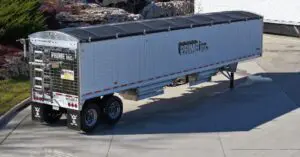You’ve earned your CDL and are ready to hit the road as a truck driver.
Before you get behind the wheel of your first big rig, you have to decide which type of truck you’ll be driving.
Truck drivers haul many types of freight across thousands of miles every day—from the foods we eat to the building materials that go into our homes. Different types of cargo require different types of trucks.
Two common modes of trucking include dry van and refrigerated (also known as reefer trucks). What is dry van? What is a reefer? In this article, we cover these two categories, including the products they carry and driver responsibilities.
If you’re ready to join the largest refrigerated trucking company in the United States, we invite you to fill out our online application and join the Prime trucking family.
What Does Dry Van Mean in Trucking?
A dry van truck hauls cargo that is not temperature-sensitive. Common examples include furniture, building materials, pallets and appliances. This type of trucking can be used for local, short-haul or long-haul shipping.
Dry van trucks come fully enclosed and protected from the elements, with no temperature or climate controls. They vary by size, weight and ease of loading, depending on the requirements of the cargo. While a dry van trailer attaches to a semi truck, a box truck or straight truck uses a single chassis.
Dry van trucks are versatile, durable and made to handle heavy loads. This mode of trucking is cost-effective as most trucks are built with a lightweight design that is easy to maneuver. Trucks range from 48 to 53 feet long and come in a range of sizes for different cargo.
Because they typically carry large items, dry van trailers must be carefully loaded to avoid overcrowding. Heavy cargo may sometimes require multiple trips to stay within legal weight limits.
Drivers who operate dry vans must adhere to the following guidelines:
- Inspect the trailer before loading cargo.
- Check for dents, rust and broken locks.
- Load the cargo for proper balance and stability, with heavier items near the bottom and lighter items toward the top.
- Secure cargo with appropriate tie-downs.
- Inspect the trailer after each delivery.
How Reefer Trucking Differs from Dry Van
The biggest difference between reefer and dry van trucking is that refrigerated trucks carry items that must be kept chilled or frozen at all times. Reefer trucks are used for all of the following product categories:
- Fresh and frozen produce
- Meats, including beef, pork, poultry and seafood
- Frozen desserts
- Beer and other chilled beverages
- Flowers
- Pharmaceuticals
Because it is one of the largest categories in the trucking industry, reefer trucking enjoys high demand, which translates into consistent work for drivers. There will always be a need for transporting fresh products in a timely fashion, and refrigerated trailers are typically low-maintenance compared to other trailer types.
Keeping cargo at the correct temperature is of utmost importance. Drivers must treat any breakdowns or delays as an emergency. An entire load can be spoiled if it sits at an incorrect temperature for even a short period of time.
Other key responsibilities of reefer drivers include:
- Inspect the vehicle prior to operation, to ensure the trailer is safe.
- Verify that the temperature inside the trailer matches the bill of lading provided by the customer, to ensure the goods are successfully maintained.
- Identify the needs for temperature stability for the cargo.
- Monitor all shipments to ensure freshness is maintained.
- Always clean the trailer thoroughly in between loads to reduce the risk of contamination.
Refrigerated Trucking at Prime Inc.
As the largest refrigerated trucking company in North America, Prime boasts a fleet of more than 6,500 reefer trucks and 11,700 temperature-controlled trailers. Reefer trucking is the largest division at Prime, with the other divisions being tanker, flatbed and intermodal.
Reefer Driver Pay
- Company solo drivers who operate a reefer can earn 0.50 cents per mile, and an additional 0.05 cents per mile for choosing lightweight trucks.
- Team drivers split earnings of 0.69 cents per mile, with a 0.26 cent split bonus for driving between 3,000 and 3,999 miles per week. The bonus increases to a 0.31 for teams who drive 4,000 or more miles per week.
- Independent contractors earn 72% of the revenue from each load transported.
Join the Largest Refrigerated Trucking Company in North America
If driving a reefer truck sounds like the right career move for you, the next step is to join Prime Inc. and get paid while you train. All you have to do is apply online for our program and obtain your CDL learner’s permit.
After you get your learner’s permit, you’ll complete the following steps:
- Complete CDL training
- Pass your CDL exam to obtain your commercial driver’s license
- Complete additional over-the-road training
After your training is finished, you’ll hit the road as either a company driver or independent contractor.
Are you ready? Apply online today or call our Recruiting Department at 866-290-1568 to speak with our team!


